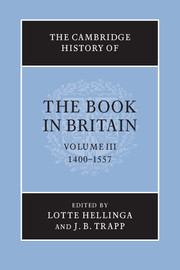Book contents
- Frontmatter
- Introduction
- 1 Literacy, books and readers
- TECHNIQUE AND TRADE
- COLLECTIONS AND OWNERSHIP
- READING AND USE OF BOOKS
- I BOOKS FOR SCHOLARS
- II PROFESSIONS
- III THE LAY READER
- 22 Schools and school-books
- 23 Practical books for the gentleman
- 24 Devotional literature
- 25 Gentlewomen’s reading
- 26 Music
- 27 Literary texts
- 28 Press, politics and religion
- Appendix
- List of abbreviations
- Bibliography
- Photo credits
- General index
- Index of manuscripts
- Bibliographic index of printed books
- Plate Section"
- References
23 - Practical books for the gentleman
from III - THE LAY READER
Published online by Cambridge University Press: 28 March 2008
- Frontmatter
- Introduction
- 1 Literacy, books and readers
- TECHNIQUE AND TRADE
- COLLECTIONS AND OWNERSHIP
- READING AND USE OF BOOKS
- I BOOKS FOR SCHOLARS
- II PROFESSIONS
- III THE LAY READER
- 22 Schools and school-books
- 23 Practical books for the gentleman
- 24 Devotional literature
- 25 Gentlewomen’s reading
- 26 Music
- 27 Literary texts
- 28 Press, politics and religion
- Appendix
- List of abbreviations
- Bibliography
- Photo credits
- General index
- Index of manuscripts
- Bibliographic index of printed books
- Plate Section"
- References
Summary
In 1486, a little more than a decade after William Caxton introduced printing to England, the Schoolmaster Printer of St Albans produced the first folio edition of The book of hawking, hunting, and blasing of arms. Wynkyn de Worde reprinted this compilation of hunting, hawking, and heraldic treatises in folio in 1496, adding to it a treatise on angling (see fig. 23.1). Having so little information about the financial workings of the earliest English presses, we cannot speak, except in qualified terms, about a ‘market’ for this or other printed editions of practical treatises in late fifteenth-century England. Still, we can reasonably assume that such rapid reprinting of the work attests to an audience eager for access to works of practical writings. Buttressing that conclusion is a colophon in the 1496 edition, in which De Worde explains why he included The Treatyse of Fysshynge with an Angle within the larger volume, rather than issuing it in a separate edition.
And for by cause that this treatyse sholde not come to the hondys of eche ydle persone whyche wolde desire it yf it were -enpryntyd allone by itself ’ put in a lytyll plaunflet therfore I haue compylyd it in a greter volume of dyuerse bokys concernynge to gentyll ’ noble men, to the entent that the forsayd ydle persons whyche sholde haue but lytyll mesure in the sayd dysporte of fysshynge sholde not by this meane vtterly dystroye it.
Keywords
- Type
- Chapter
- Information
- The Cambridge History of the Book in Britain , pp. 470 - 494Publisher: Cambridge University PressPrint publication year: 1999
References
- 6
- Cited by

